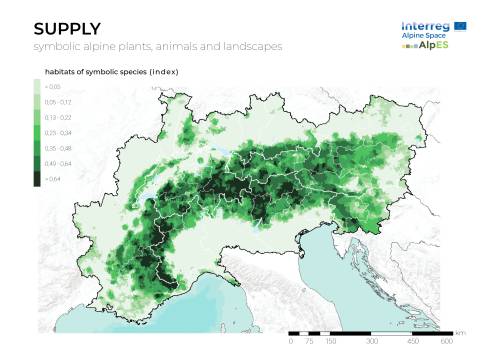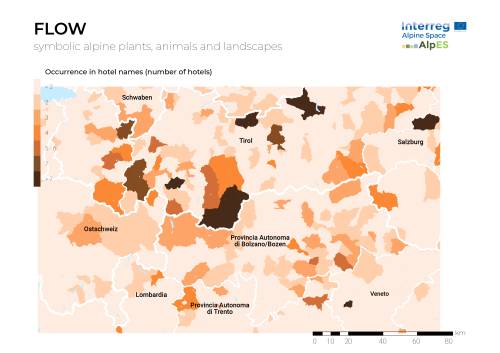Symbolic Alpine plants, animals and landscapes
The Alps are one of the richest biodiversity hotspots in Europe and are home to many endemic plant and animal species. These species have become intertwined with the many cultures that have developed here; they have symbolic meaning to people who call the Alps home. A well-known example is the edelweiss, a beautiful, diminutive white flower found high in rocky mountain environs. The edelweiss has been a symbol for different alpine militaries, represented intrepidness in the mountains, and even been a part of many songs from the region. Many other species have symbolic meaning in the Alps, including ibex, chamois, golden eagle, alpenrose, larch, and more. Calculating the impacts of ecosystem services with such nonmaterial benefits as symbolic plants, animals and landscapes is no easy task. The intangible nature of symbols, especially their
value, use, and extent, render traditional spatial analysis methods exceedingly difficult. This set of indicators thus develops novel methodologies to assess this service. Supply of this service is evaluated by examining the geographic ranges of the selected culturally important plant and animal species. By tracking the use of these species in hotel names per municipality, the flow of this service is mapped. Given the personal, qualitative nature of symbols and their importance, no demand indicator has been mapped for this ecosystem service, although a qualitative evaluation of the population’s demand has been carried out through an online questionnaire. Appraising the value of these symbols proves to be challenging,but is vital in a deeper understanding of the benefits we draw from the environment around us. This is especially true as landuse and climate changes threaten many of the species that are most important to the cultures found in the Alpine Space.
Supply

View this map in the AlpES webGIS
The Alps are one of the richest biodiversity hotspots in Europe and are home to many endemic plant and animal species. Many of these species are so characteristic of the Alps that they have become a symbol of Alpine culture and traditions. This indicator is based on the geographic range of 10 Alpine species, polled by the AlpES partners, to estimate an index of symbolic species richness. The selected animal species include ungulates like the Alpine ibex and the chamois; charismatic predators, such as brown bear and golden eagle; and one of the most abundant mountain rodents, the marmot. The plant species comprise symbolic flowers like edelweiss, alpenrose (Fig. 3.19) and
gentian, and conifers like the European larch and several pine species. All these species are essential components of the Alpine landscape. Nonetheless, many of them are now threatened, and some have almost completely vanished from the Alpine Space. The brown bear, for example, has been extirpated from most of its historic range, which covered the entire Alps. Today, the only extant breeding populations are in Slovenia and in the province of Trentino, Italy, where a reintroduction program saved the local population from extinction. Alpine ibexes had also been eradicated from the Alps in the early 19th century, except for the population in Gran Paradiso National Park. Since then, reintroduction programs have repopulated the Alpine peaks with these elusive creatures. Plant species too have been subject to serious andcontinuous threats: flowers like the edelweiss and the gentian were all too frequently collected in the wild for ornamental or medicinal purposes. Now, legislation in many Alpine countries prohibits the picking of such species in the wild (IUCN, n.d.). Most of these species live at high altitudes, as the resulting map shows. The central and southwestern Alps are the richest in symbolic Alpine species. High values of this indicator relate to a higher species richness and diversity of the ecosystem, which are important features of a healthy ecosystem.
Flow
Iconic animal and plant species are not only important components of the Alpine ecosystem; they have become part of the cultural heritage of local communities. They appear on traditional dresses, on logos of Alpine associations and in the coat of arms of municipalities. The edelweiss is even represented on the backside of the Austrian two-cent Euro coin. These examples reflect how deeply rooted these species are in Alpine identities. Symbolic species are also well represented in the names of hotels, guesthouses, restaurants and the like. The flow indicator evaluates this specific usage of the symbolic value of Alpine species. For its calculation, we searched the official registries and used
automatic routines to scrape online databases (e.g. booking sites) to find all tourist accommodation facilities which had symbolic Alpine plants or animals in their names.
However, as the data pool was too scarce to create a pan-Alpine map, this indicator was mapped on an exemplary basis for the Alpine regions of Tyrol and South Tyrol (Fig. 3.11). When looking at this map, it becomes clear that the habit of naming hotels after symbolic species is particularly common for many of tourism-prone municipalities in the central Alps. Here, mountain huts are scattered along the network of hiking trails, providing refreshment and shelter to the visitors. Valley bottom municipalities have fewer such hotels, and hotels with symbolic species in their name occur only sporadically outside the main mountain range. In general, it seems that the representation of symbolic Alpine species is not so strongly correlated to their actual presence in the area, but rather that it is used to reaffirm the sense of belonging to a specific region or cultural identity, even in places where such species are not present. Indeed, in many cases the symbolic value of an animal or plant can persist in case of extinction (Schirpke et al., 2018).

<font 10px/inherit;;inherit;;inherit>Figure 3.11 Number of hotels holding symbolic species in their names in the central Alpine regions of Tyrol and South Tyrol.</font>
Demand
The importance and value of symbolic Alpine animals, plants and landscapes are highly subjective and therefore not easy to assess. Their demand and use are often detached from their occurrence in natural systems and do not necessarily require their presence in the environmental setting. For these reasons, spatially mapping the demand was not appropriate for this ES. However, the characteristics of demand for symbolic Alpine entities were assessed through a multilingual questionnaire. This online survey about perception and preferences for symbolic entities had more than 500 respondents in all project partners’ countries. Participants were asked which animals, plants and landscapes they consider to be symbolic for the Alpine Space, which landscape elements have the strongest symbolic character, and in which context they are used (e.g. outdoor activities, cultural ecosystem services [CES]). Answers are analysed and discussed considering the personal context of respondents, such as residence, birthplace, as well as personal, cultural and sociodemographic characteristics. The results of the questionnaire are still in processing, but will likely be published by Seppi et al. and Rüdisser, Schirpke, Rampl & Tappeiner (in preparation). Despite the different format of measurement and the absence of an indicator map, these findings will be useful for a comparison between the distributions of the ES demand with its supply and flow.